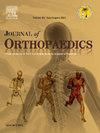Factors associated with stiff knee gait in patients with knee osteoarthritis
IF 1.5
Q3 ORTHOPEDICS
引用次数: 0
Abstract
Background
Stiff knee gait (SKG) is a common gait pattern in patients with knee osteoarthritis (KOA), characterized by reduced knee flexion excursion during gait. SKG can accelerate KOA progression; however, its underlying mechanisms and associated factors remain unclear. This study aimed to provide preliminary evidence on SKG-associated factors in patients with KOA.
Methods
A pilot cross-sectional study was conducted at a single facility, including 21 patients with KOA undergoing rehabilitation. Knee flexion excursion during gait was assessed using a posture estimation library, classifying participants into SKG+ and SKG−. Evaluations covered pain intensity, muscle strength, knee range of motion (ROM), KOA severity, gait speed, fall efficacy, and health-related quality of life (QOL). Results were compared between groups to identify factors associated with SKG, and significant differences were analyzed for correlations with knee flexion excursion.
Results
Among the 21 participants, 9 and 12 were in the SKG+ and SKG− groups, respectively. Significant differences were observed between the groups in pain intensity, quadriceps muscle strength, knee flexion ROM, and Western Ontario and McMaster Universities osteoarthritis index functional and total scores. Correlation analysis revealed that knee flexion excursion was moderately negatively correlated with pain intensity, moderately positively correlated with quadriceps muscle strength, and strongly positively correlated with knee flexion ROM.
Conclusion
This study suggests that SKG in patients with KOA is associated with greater pain intensity, reduced quadriceps muscle strength, and decreased knee ROM. SKG may also negatively affect QOL. These preliminary findings indicate that targeted interventions addressing these factors could prevent and improve SKG.
膝骨关节炎患者膝关节僵硬步态的相关因素
背景:膝关节僵硬步态(SKG)是膝关节骨关节炎(KOA)患者常见的步态模式,其特征是步态时膝关节屈曲偏移减少。SKG可以加速KOA进程;然而,其潜在机制和相关因素尚不清楚。本研究旨在为KOA患者skg相关因素提供初步证据。方法在单一机构进行了一项试点横断面研究,包括21例接受康复治疗的KOA患者。使用姿势估计库评估步态中的膝关节屈曲偏移,将参与者分为SKG+和SKG−。评估包括疼痛强度、肌肉力量、膝关节活动范围(ROM)、KOA严重程度、步态速度、跌倒疗效和健康相关生活质量(QOL)。比较各组之间的结果以确定与SKG相关的因素,并分析与膝关节屈曲偏移相关的显著差异。结果21例患者中,SKG+组9例,SKG−组12例。在疼痛强度、股四头肌力量、膝关节屈曲ROM、西安大略省和麦克马斯特大学骨关节炎指数功能和总分方面,组间存在显著差异。相关分析显示,膝关节屈曲偏移与疼痛强度呈中负相关,与股四头肌力量呈中正相关,与膝关节屈曲ROM呈强正相关。结论KOA患者的SKG与疼痛强度升高、股四头肌力量降低、膝关节ROM降低相关,SKG也可能对生活质量产生负向影响。这些初步研究结果表明,针对这些因素的针对性干预可以预防和改善SKG。
本文章由计算机程序翻译,如有差异,请以英文原文为准。
求助全文
约1分钟内获得全文
求助全文
来源期刊

Journal of orthopaedics
ORTHOPEDICS-
CiteScore
3.50
自引率
6.70%
发文量
202
审稿时长
56 days
期刊介绍:
Journal of Orthopaedics aims to be a leading journal in orthopaedics and contribute towards the improvement of quality of orthopedic health care. The journal publishes original research work and review articles related to different aspects of orthopaedics including Arthroplasty, Arthroscopy, Sports Medicine, Trauma, Spine and Spinal deformities, Pediatric orthopaedics, limb reconstruction procedures, hand surgery, and orthopaedic oncology. It also publishes articles on continuing education, health-related information, case reports and letters to the editor. It is requested to note that the journal has an international readership and all submissions should be aimed at specifying something about the setting in which the work was conducted. Authors must also provide any specific reasons for the research and also provide an elaborate description of the results.
 求助内容:
求助内容: 应助结果提醒方式:
应助结果提醒方式:


